Abstract
Differences in nephropathogenicity between Escherichia coli strains were studied by following the kinetics of the viable count in the mouse kidney during 8 h after intravenous injection. Assuming as a reference point that at zero time 0.1% of the inoculum was lodged in the kidney, we found that strains fell into three main groups with different behavior patterns: in group I, the viable count fell and remained low; in group II, the viable count first fell and then rose after 4 h, reaching the level of the reference point within 8 h; in group III, the viable count rose rapidly and remained high. The kinetics of the viable counts were also studied in blood, spleen, and liver: group I and II strains behaved similarly; only in the kidney did group II strains show higher counts than group I strains. These data suggest that group II strains are specifically virulent for the mouse kidney. Group III strains also gave higher viable counts in blood and spleen but comparable counts in the liver, suggesting that group III strains are more generally virulent. Fifty percent lethal dose measurements confirmed the conclusion that group I strains are avirulent and group III strains are the most virulent. Possible relationships between behavior pattern and serotype are discussed.
Full text
PDF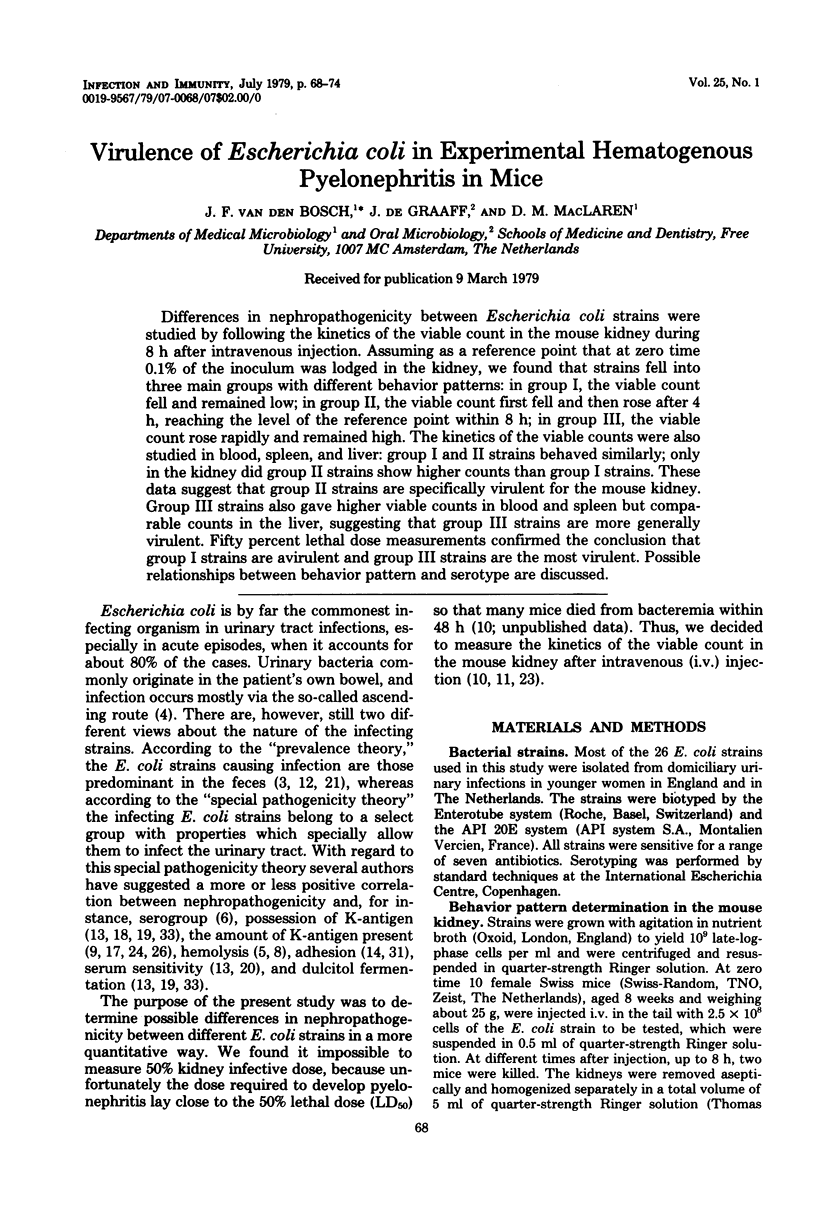
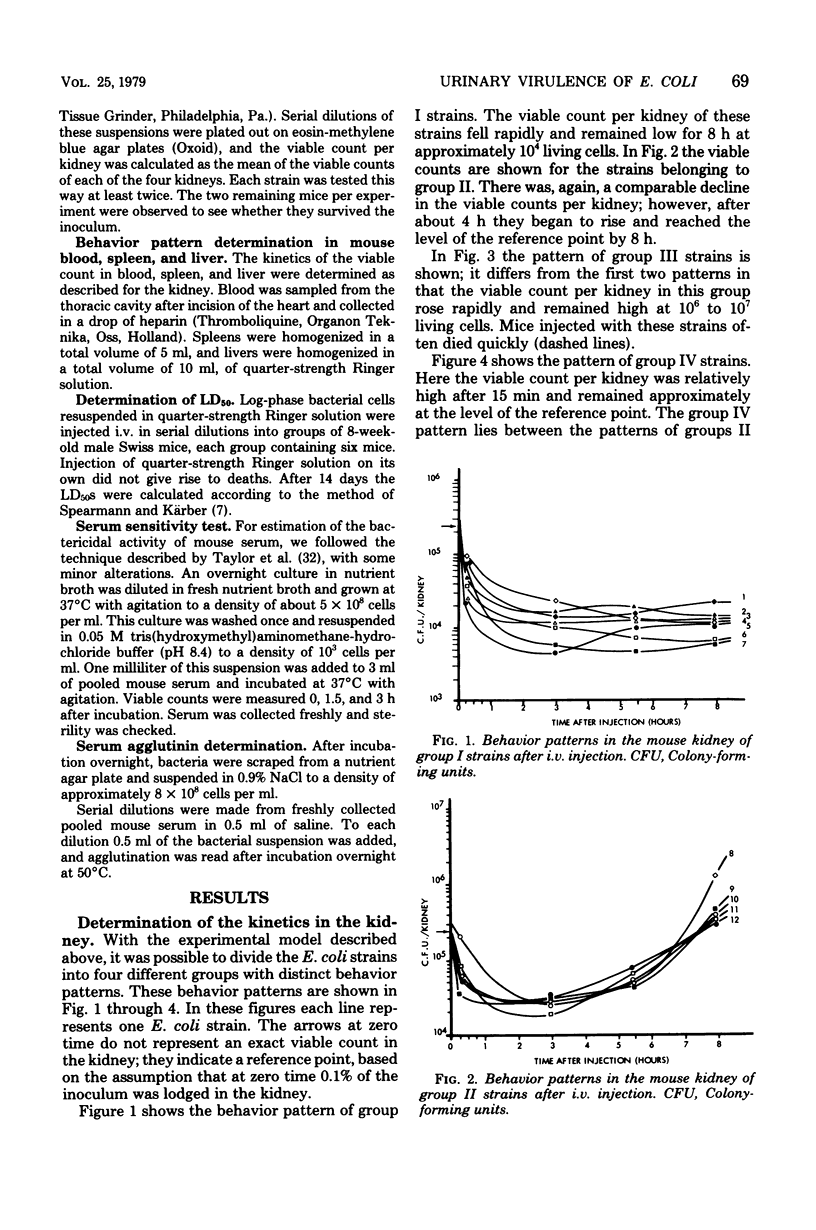
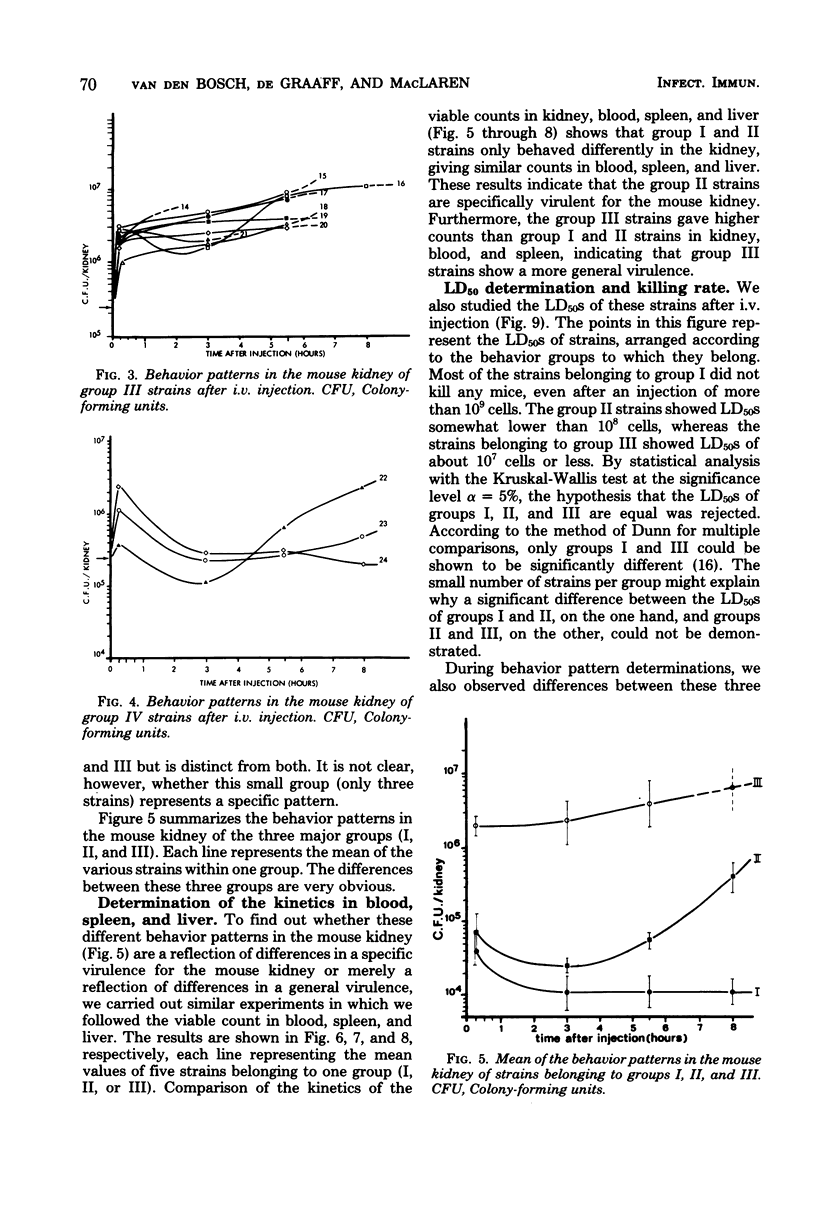
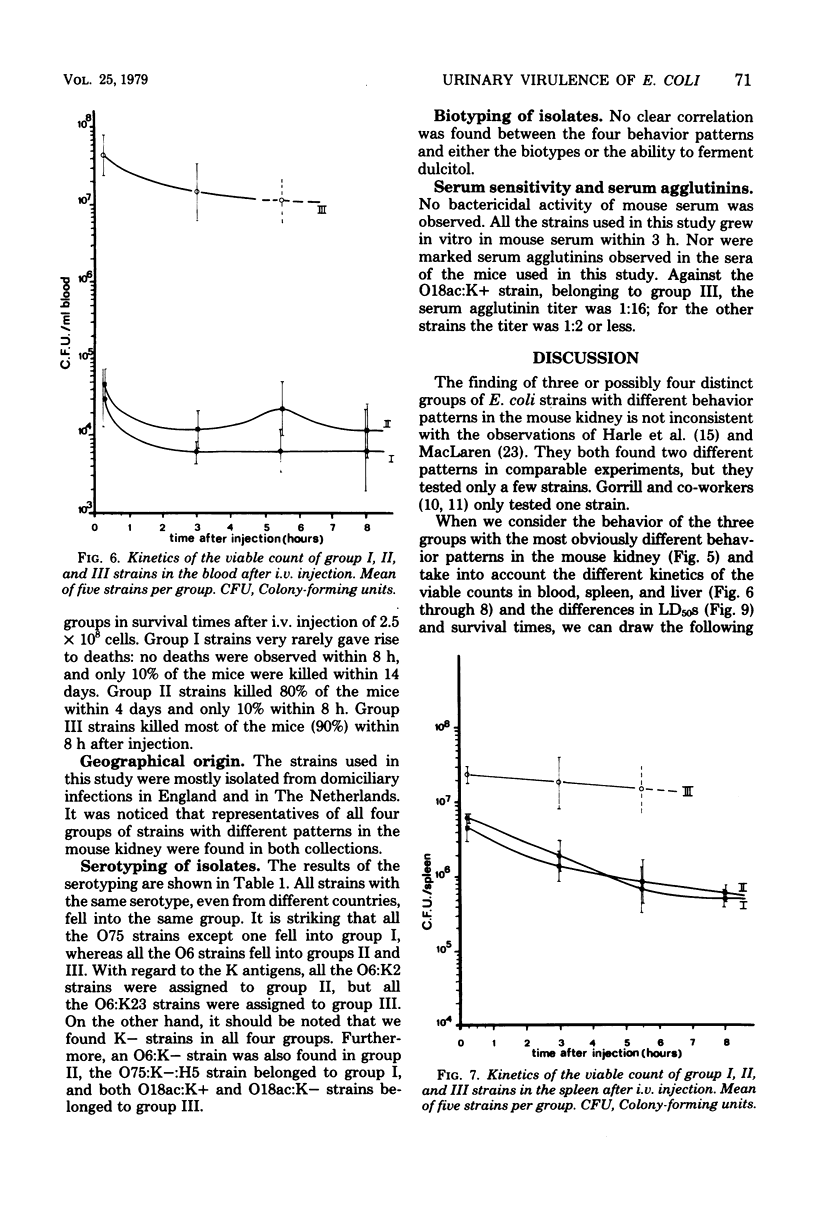
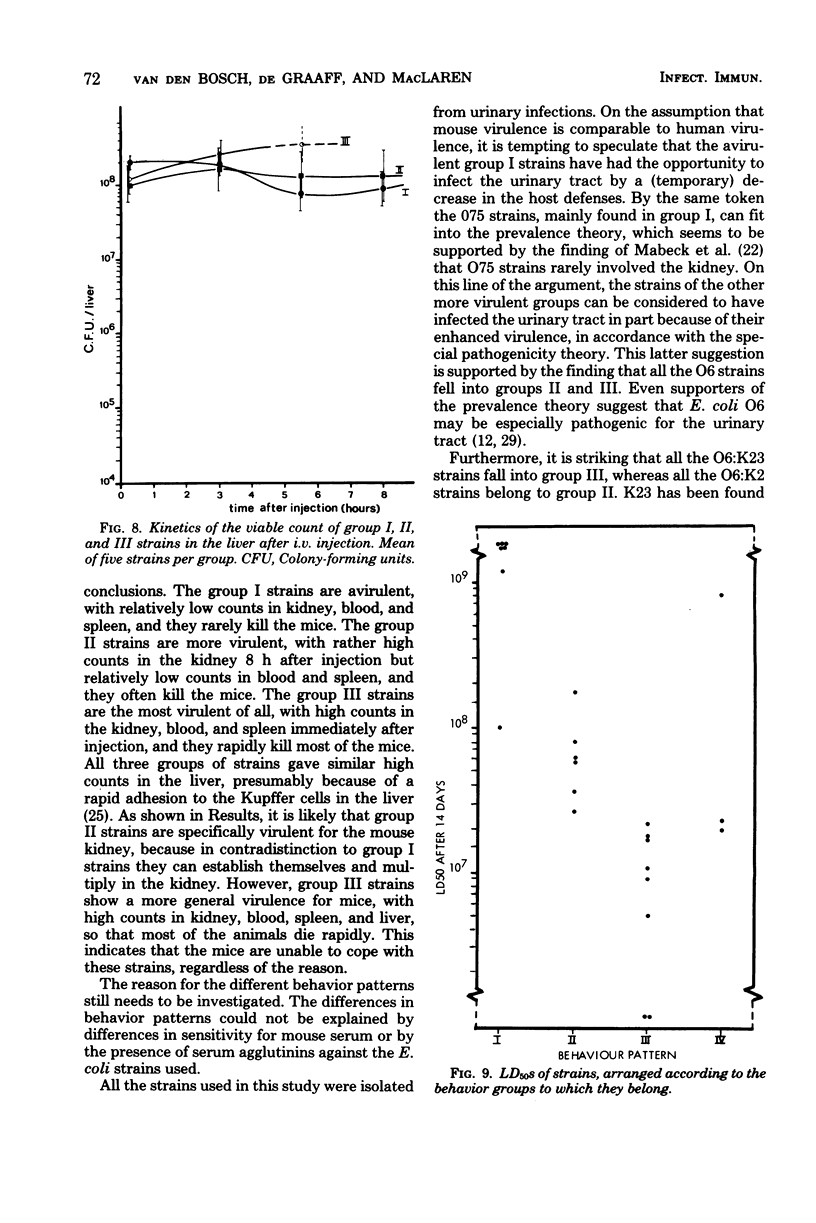
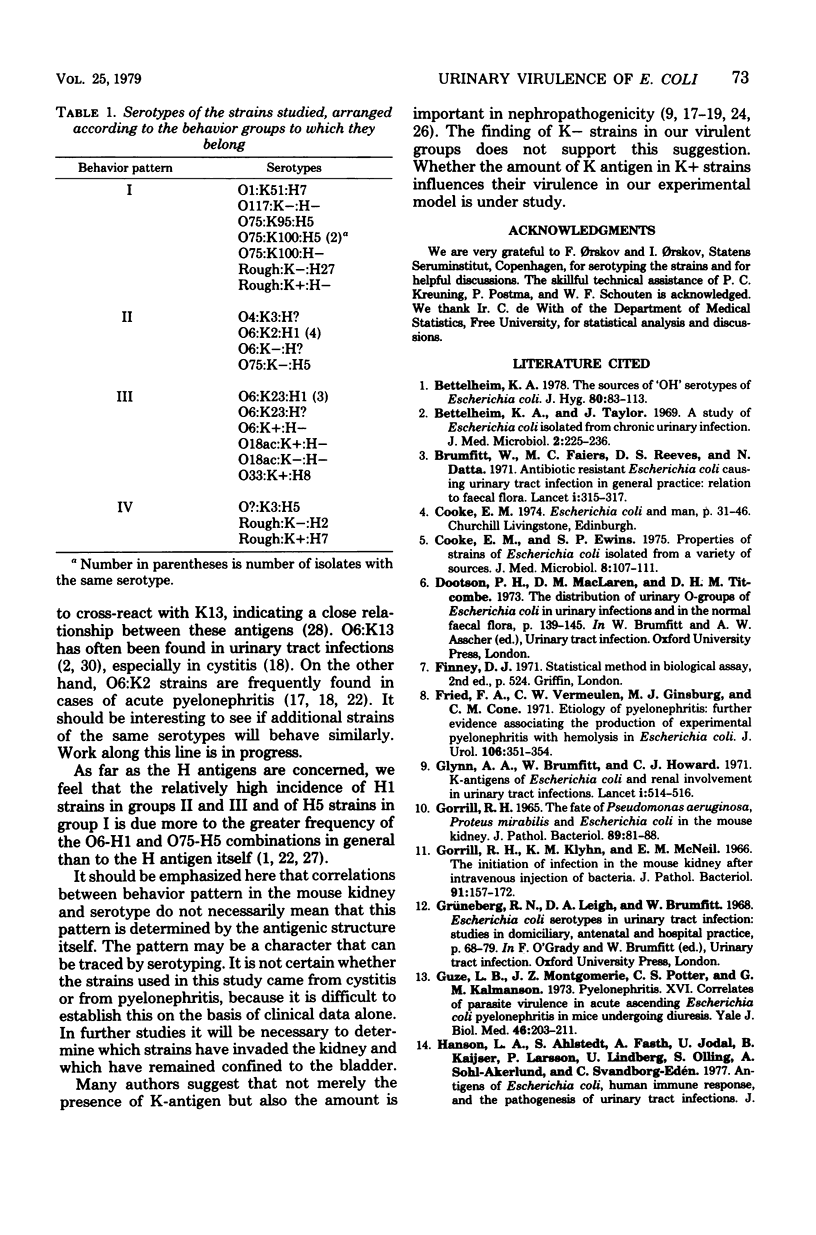
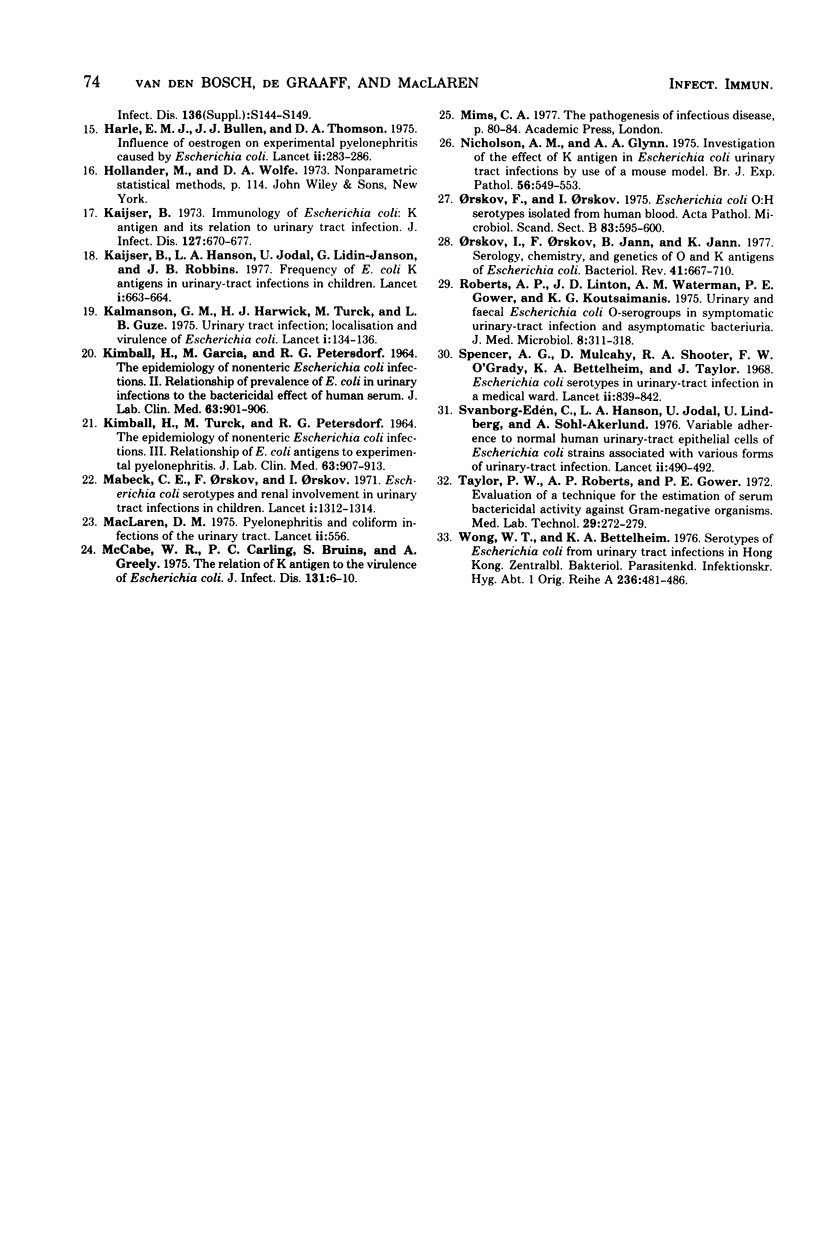
Selected References
These references are in PubMed. This may not be the complete list of references from this article.
- Bettelheim K. A., Taylor J. A study of Escherichia coli isolated from chronic urinary infection. J Med Microbiol. 1969 Aug;2(3):225–236. doi: 10.1099/00222615-2-3-225. [DOI] [PubMed] [Google Scholar]
- Bettelheim K. A. The sources of "OH" serotypes of Escherichia coli. J Hyg (Lond) 1978 Feb;80(1):83–113. doi: 10.1017/s0022172400053420. [DOI] [PMC free article] [PubMed] [Google Scholar]
- Brumfitt W., Faiers M. C., Reeves D. S., Datta N. Antibiotic-resistant Escherichia coli causing urinary-tract infection in general practice: relation to faecal flora. Lancet. 1971 Feb 13;1(7694):315–317. doi: 10.1016/s0140-6736(71)91043-9. [DOI] [PubMed] [Google Scholar]
- Cooke E. M., Ewins S. P. Properties of strains of Escherichia coli isolated from a variety of sources. J Med Microbiol. 1975 Feb;8(1):107–111. doi: 10.1099/00222615-8-1-107. [DOI] [PubMed] [Google Scholar]
- Edén C. S., Hanson L. A., Jodal U., Lindberg U., Akerlund A. S. Variable adherence to normal human urinary-tract epithelial cells of Escherichia coli strains associated with various forms of urinary-tract infection. Lancet. 1976 Sep 4;1(7984):490–492. [PubMed] [Google Scholar]
- Fried F. A., Vermeulen C. W., Ginsburg M. J., Cone C. M. Etiology of pyelonephritis: further evidence associating the production of experimental pyelonephritis with hemolysis in Escherichia coli. J Urol. 1971 Sep;106(3):351–354. doi: 10.1016/s0022-5347(17)61286-2. [DOI] [PubMed] [Google Scholar]
- GORRILL R. H. THE FATE OF PSEUDOMONAS AERUGINOSA, PROTEUS MIRABILIS AND ESCHERICHIA COLI IN THE MOUSE KIDNEY. J Pathol Bacteriol. 1965 Jan;89:81–88. doi: 10.1002/path.1700890110. [DOI] [PubMed] [Google Scholar]
- Glynn A. A., Brumfitt W., Howard C. J. K antigens of Escherichia coli and renal involvement in urinary-tract infections. Lancet. 1971 Mar 13;1(7698):514–516. [PubMed] [Google Scholar]
- Gorrill R. H., Klyhn K. M., McNeil E. M. The initiation of infection in the mouse kidney after intravenous injection of bacteria. J Pathol Bacteriol. 1966 Jan;91(1):157–172. doi: 10.1002/path.1700910120. [DOI] [PubMed] [Google Scholar]
- Guze L. B., Montgomerie J. Z., Potter C. S., Kalmanson G. M. Pyelonephritis XVI. correlates of parasite virulence in acute ascending Escherichia coli pyelonephritis in mice undergoing diuresis. Yale J Biol Med. 1973 Jun;46(3):203–211. [PMC free article] [PubMed] [Google Scholar]
- Harle E. M., Bullen J. J., Thomson D. A. Influence of oestrogen on experimental pyelonephritis caused by Escherichia coli. Lancet. 1975 Aug 16;2(7929):283–286. doi: 10.1016/s0140-6736(75)92726-9. [DOI] [PubMed] [Google Scholar]
- KIMBALL H., GARCIA M., PETERSDORF R. G. THE EPIDEMIOLOGY OF NONENTERIC ESCHERICHIA COLI INFECTIONS. II. RELATIONSHIP OF PREVALENCE OF E. COLI IN URINARY INFECTIONS TO THE BACTERICIDAL EFFECT OF HUMAN SERUM. J Lab Clin Med. 1964 Jun;63:901–906. [PubMed] [Google Scholar]
- KIMBALL H., TURCK M., PETERSDORF R. G. THE EPIDEMIOLOGY OF NONENTERIC ESCHERICHIA COLI INFECTIONS. III. RELATIONSHIP OF E. COLI ANTIGENS TO EXPERIMENTAL PYELONEPHRITIS. J Lab Clin Med. 1964 Jun;63:907–913. [PubMed] [Google Scholar]
- Kaijser B., Hanson L. A., Jodal U., Lidin-Janson G., Robbins J. B. Frequency of E. coli K antigens in urinary-tract infections in children. Lancet. 1977 Mar 26;1(8013):663–666. doi: 10.1016/s0140-6736(77)92111-0. [DOI] [PubMed] [Google Scholar]
- Kaijser B. Immunology of Escherichia coli: K antigen and its relation to urinary-tract infection. J Infect Dis. 1973 Jun;127(6):670–677. doi: 10.1093/infdis/127.6.670. [DOI] [PubMed] [Google Scholar]
- Kalmanson G. M., Harwick H. J., Turck M., Guze L. B. Urinary-tract infection: localisation and virulence of Escherichia coli. Lancet. 1975 Jan 18;1(7899):134–136. doi: 10.1016/s0140-6736(75)91430-0. [DOI] [PubMed] [Google Scholar]
- Mabeck C. E., Orskov F., Orskov I. Escherichia coli serotypes and renal involvement in urinary-tract infection. Lancet. 1971 Jun 26;1(7713):1312–1314. doi: 10.1016/s0140-6736(71)91884-8. [DOI] [PubMed] [Google Scholar]
- MacLaren D. M. Letter: Pyelonephritis and coliform infections of the urinary tract. Lancet. 1975 Sep 20;2(7934):556–556. doi: 10.1016/s0140-6736(75)90933-2. [DOI] [PubMed] [Google Scholar]
- McCabe W. R., Carling P. C., Bruins S., Greely A. The relation of K-antigen to virulence of Escherichia coli. J Infect Dis. 1975 Jan;131(1):6–10. doi: 10.1093/infdis/131.1.6. [DOI] [PubMed] [Google Scholar]
- Nicholson A. M., Glynn A. A. Investigation of the effect of K antigen in Escherichia coli urinary tract infections by use of a mouse model. Br J Exp Pathol. 1975 Dec;56(6):549–553. [PMC free article] [PubMed] [Google Scholar]
- Orskov F., Orskov I. Escherichia coli O:H serotypes isolated from human blood. Prevalence of the K1 antigen with technical details of O and H antigenic determination. Acta Pathol Microbiol Scand Suppl. 1975 Dec;83(6):595–600. [PubMed] [Google Scholar]
- Orskov I., Orskov F., Jann B., Jann K. Serology, chemistry, and genetics of O and K antigens of Escherichia coli. Bacteriol Rev. 1977 Sep;41(3):667–710. doi: 10.1128/br.41.3.667-710.1977. [DOI] [PMC free article] [PubMed] [Google Scholar]
- Roberts A. P., Linton J. D., Waterman A. M., Gower P. E., Koutsaimanis K. G. Urinary and faecal Escherichia coli O-sero-groups in symptomatic urinary-tract infection and asymptomatic bacteriuria. J Med Microbiol. 1975 May;8(2):311–318. doi: 10.1099/00222615-8-2-311. [DOI] [PubMed] [Google Scholar]
- Spencer A. G., Mulcahy D., Shooter R. A., O'Grady F. W., Bettleheim K. A., Taylor J. Escherichia coli serotypes in urinary-tract infection in a medical ward. Lancet. 1968 Oct 19;2(7573):839–842. doi: 10.1016/s0140-6736(68)90998-7. [DOI] [PubMed] [Google Scholar]
- Taylor P. W., Roberts A. P., Gower P. E. Evaluation of a technique for the estimation of serum bactericidal activity against Gram-negative organisms. Med Lab Technol. 1972 Jul;29(3):272–279. [PubMed] [Google Scholar]
- Wong W. T., Bettelheim K. A. Serotypes of Escherichia coli from urinary tract infections in Hong Kong. Zentralbl Bakteriol Orig A. 1976 Dec;236(4):481–486. [PubMed] [Google Scholar]


